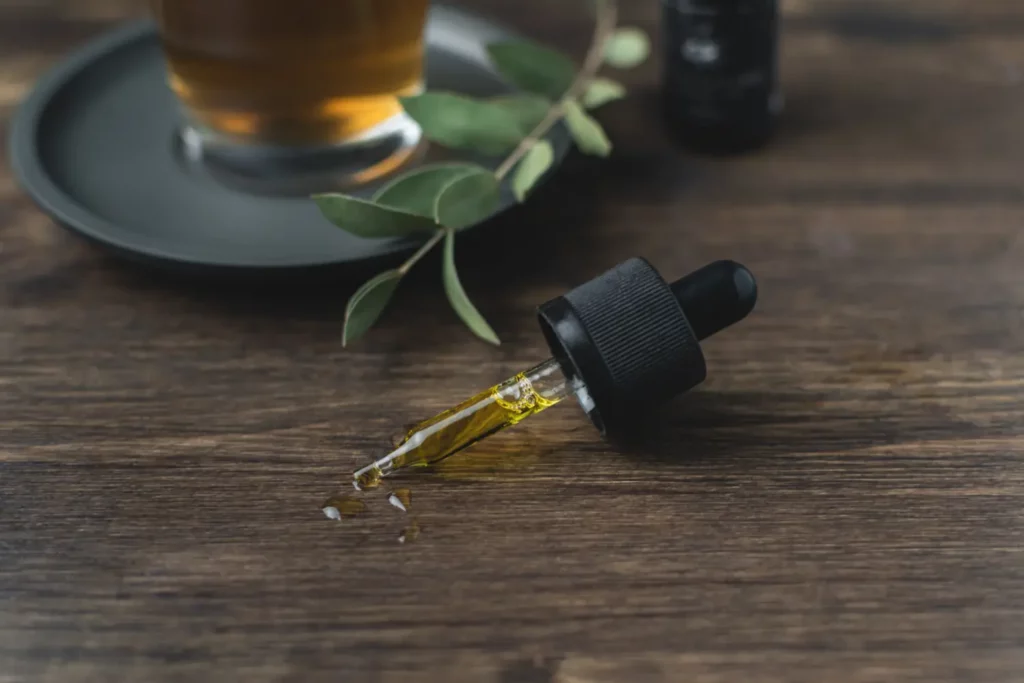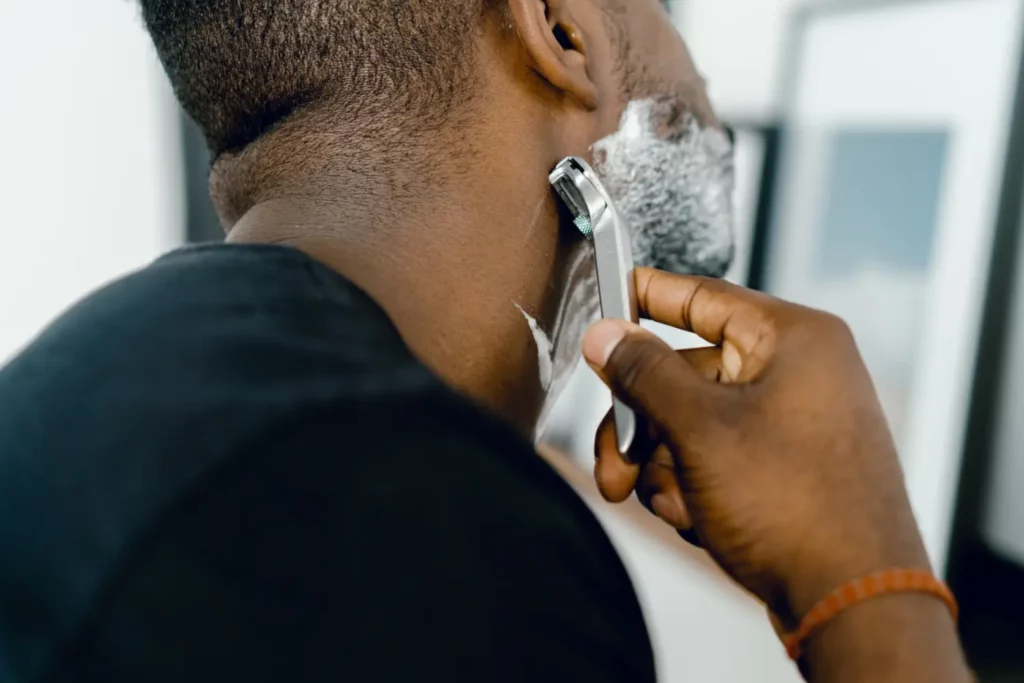Shaving your neck with a safety razor can be a daunting task, especially considering the neck is a sensitive and difficult-to-maneuver area.
However, with a few tricks and the right approach, you can achieve a close and comfortable shave without irritation or razor burn.
We’ll walk you through some time-tested techniques and tips that will greatly improve your shaving experience and result in a smooth, nick-free neck.
Key Takeaways
- Prepare your neck by softening the hair and opening the pores with a hot shower or hot towel.
- Map your neck’s unique contours and understand the direction of hair growth.
- Use short strokes and apply no pressure when using a safety razor.
- Rinse with cold water and apply an aftershave balm for a smooth finish.
- Study and practice the process for a clean, comfortable shave without irritation.
1. Studying the Contours of Your Neck
Before pre-shave oil, shaving cream, or any other products touch your neck, it’s essential to examine the curves, bumps, and hair growth patterns on your neck. This will help you understand how to angle your safety razor and determine the best direction to shave in to accurately trim your facial hair along the neckline.
Everyone’s neck is different, and mapping your neck’s shape and contours will ensure that you’re shaving in the most effective manner. Specifically, you’ll want to pay attention to where there may be dimples or raised and recessed areas, as these are the spots where you’ll need to adjust your technique slightly to avoid nicks and irritation.
2. Determining the Grain of Your Hair
Aside from the underlying structure of your neck, it’s important to determine the grain or the direction in which your neck hair grows. Shaving with the grain (in the direction your hair grows) will result in a more comfortable shave and reduce the likelihood of irritation and ingrown hairs.
To find the grain of your neck hair, gently run your fingers across the stubble, noticing which direction feels smoother (this is the direction of hair growth). Unfortunately, for many men, the direction of hair growth on the neck can be inconsistent and change in various spots, so take your time when mapping out the grain to ensure maximum comfort during the shaving process.
When using a safety razor, it’s best to follow the direction of hair growth to minimize the risk of ingrown hairs and razor bumps.
3. Preparing Your Neck for a Clean Shave

Before you begin, it’s important to prepare your neck for shaving, especially if you have sensitive skin. This means you’ll want to take a hot shower or use a hot towel to soften the hair, making it much easier to cut. We advise against just splashing warm water on your neck, as this won’t provide the same level of softening and pore opening that a hot shower or towel can offer.
Additionally, exfoliating the area gently will remove any dead skin cells, reducing the risk of ingrown hairs and allowing for a smoother shave.
For beginners especially, we recommend using a pre-shave oil or cream to provide extra lubrication, which helps the razor glide effortlessly across your skin and prevents friction. This extra layer of protection will also minimize the chances of nicks and cuts.
In addition to pre-shave oil, use a traditional shaving cream like a high-quality glycerin-based product or a shave soap lathered with a shaving brush. These provide excellent cushioning and lubrication to help prevent irritation and allow the razor to glide smoothly over the contours of your neck.
Pro Tip: You never want to try and shave with a razor blade that has become dull or damaged. Safety razor blades are good for 5 to 7 shaves, but this can vary depending on the individual and the thickness of their hair. Always replace your razor blade when it starts to feel dull or tugs at your skin, as using a dull blade can increase the risk of irritation and nicks.
4. Pulling Your Skin Taut
When shaving your neck, it’s essential to flatten the skin for a smoother surface, especially when working on the sideburns, chin, and hairline areas. This becomes particularly important for an older gentleman as the skin doesn’t have the same elasticity as it once did. To achieve this, gently pull the skin with one hand while holding the razor in the other, ensuring you create a taut but not overly tight surface. This will help the razor glide more easily and reduce the risk of nicks and cuts.
Some folks think that over-stretching the skin can result in a closer shave, but in reality, you are causing mild damage to the skin and increasing the chances of irritation and razor burn. So, always remember to strike a balance between creating a flat surface and maintaining your skin’s natural elasticity while shaving your neck.
5. Mastering the Art of Shaving Passes
Shaving passes are crucial for a closer shave without irritation. Shaving with a safety razor is broken into three core components
- With the Grain (WTG ): This is the first pass, where you shave in the direction of your hair growth. It helps to remove most of the hair without causing any irritation or discomfort. Make sure to use a light touch and let the weight of the razor do the work.
- Across the Grain ( XTG): For the second pass, shave perpendicular to the direction of hair growth if you want smooth results. XTG shaving reduces hair length even further and helps prevent ingrown hairs. Remember to reapply shaving cream or soap before each passes to maintain proper lubrication and protection.
- Against the Grain (ATG): This final pass is optional and should only be attempted if you have mastered the first two passes and have no signs of irritation or discomfort. Shaving against the grain provides the closest shave possible, but it also comes with the highest risk of causing irritation, razor burn, and ingrown hairs. If you choose to perform an ATG pass, make sure to use very light pressure and be extra careful around the contours of your neck to avoid nicks and cuts.
6. Utilizing Shorter Strokes for Precision

Using shorter strokes with a safety razor will allow you to maintain better control and follow the curves of your neck. It’s also easier to adjust the angle of the razor blade as you are shaving, ensuring the optimal contact with your skin at all times. Short strokes provide greater precision and help reduce the risk of nicks, cuts, and irritation.
7. Shaving the Tricky Adam’s Apple Area
The Adam’s apple area can be quite challenging to shave. To make it easier, try swallowing and holding your swallow. This will temporarily flatten the area, allowing you to shave it more easily. Be sure to use light, short strokes during this process to avoid nicks and cuts. This may take a few attempts to master, but with practice, you’ll be able to navigate this tricky spot with ease and confidence.
8. Perfecting the No-Pressure Technique
Safety razors are designed to cut hair with minimal pressure, so remember not to press the razor against your skin. This is the number one mistake that men make when using a safety razor, as applying too much pressure increases the risk of nicks, cuts, and irritation. Instead, let the weight of the razor do the work and simply guide it along your skin in the direction of hair growth. This no-pressure technique will ensure a close, comfortable shave without any unwanted side effects.
9. Cleaning Up After the Shave
Once you’ve completed your shave, rinse your neck with cold water to close the pores and prepare your skin for aftershave. Apply an aftershave balm or lotion to soothe and moisturize your skin.
Remember that using alcohol-based aftershaves can cause dryness, so go for one that provides moisture and nourishment.